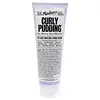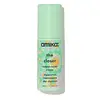What's inside
What's inside
 Key Ingredients
Key Ingredients

No key ingredients
 Benefits
Benefits

 Concerns
Concerns

 Ingredients Side-by-side
Ingredients Side-by-side

Water
Skin ConditioningParaffinum Liquidum
EmollientPEG-12
HumectantDimethicone
EmollientGlycerin
HumectantAcrylic Acid/Vp Crosspolymer
Parfum
MaskingPhenoxyethanol
PreservativeCaprylyl Glycol
EmollientEthylhexylglycerin
Skin ConditioningAloe Barbadensis Leaf Juice
Skin ConditioningGlycine Soja Oil
EmollientEthylhexyl Methoxycinnamate
UV AbsorberOleth-5
EmulsifyingAminomethyl Propanol
BufferingPersea Gratissima Oil
Skin ConditioningButyrospermum Parkii Butter
Skin ConditioningPrunus Amygdalus Dulcis Oil
Skin ConditioningSimmondsia Chinensis Seed Oil
EmollientMacadamia Integrifolia Seed Oil
Skin ConditioningSilk Amino Acids
HumectantDisodium EDTA
CI 60725
Cosmetic ColorantWater, Paraffinum Liquidum, PEG-12, Dimethicone, Glycerin, Acrylic Acid/Vp Crosspolymer, Parfum, Phenoxyethanol, Caprylyl Glycol, Ethylhexylglycerin, Aloe Barbadensis Leaf Juice, Glycine Soja Oil, Ethylhexyl Methoxycinnamate, Oleth-5, Aminomethyl Propanol, Persea Gratissima Oil, Butyrospermum Parkii Butter, Prunus Amygdalus Dulcis Oil, Simmondsia Chinensis Seed Oil, Macadamia Integrifolia Seed Oil, Silk Amino Acids, Disodium EDTA, CI 60725
Water
Skin ConditioningAloe Barbadensis Leaf Juice
Skin ConditioningDimethicone
EmollientIsopropyl Palmitate
EmollientGlyceryl Stearate Se
EmulsifyingGlycerin
HumectantCetearyl Alcohol
EmollientCetearyl Glucoside
EmulsifyingPolyquaternium-55
Hippophae Rhamnoides Fruit/Seed Oil
AntimicrobialBorago Officinalis Seed Oil
EmollientMangifera Indica Seed Butter
Skin ConditioningButyrospermum Parkii Butter
Skin ConditioningGuar Hydroxypropyltrimonium Chloride
Skin ConditioningGalactoarabinan
Camellia Sinensis Leaf Extract
AntimicrobialLavandula Angustifolia Flower Extract
CleansingPanthenol
Skin ConditioningHydrolyzed Quinoa
Skin ConditioningHydrolyzed Rice Protein
Skin ConditioningHydrolyzed Adansonia Digitata Seed Extract
Hydrolyzed Vegetable Protein
Skin ConditioningCoco-Caprylate/Caprate
EmollientCoconut Alkanes
EmollientOlealkonium Chloride
Cinnamidopropyltrimonium Chloride
Polyquaternium-11
Coceth-7
EmulsifyingButylene Glycol
HumectantAcrylamidopropyltrimonium Chloride/Acrylates Copolymer
Bis-PCA Dimethicone
Disodium PEG-12 Dimethicone Sulfosuccinate
CleansingIsohexadecane
EmollientAminomethyl Propanol
BufferingCaprylyl Glycol
EmollientSorbitan Isostearate
EmulsifyingPotassium Sorbate
PreservativeSodium Benzoate
MaskingCitric Acid
BufferingBenzyl Alcohol
PerfumingAlcohol
AntimicrobialPhenoxyethanol
PreservativeParfum
MaskingBenzyl Benzoate
AntimicrobialHydroxycitronellal
PerfumingLimonene
PerfumingCitronellol
PerfumingCoumarin
PerfumingWater, Aloe Barbadensis Leaf Juice, Dimethicone, Isopropyl Palmitate, Glyceryl Stearate Se, Glycerin, Cetearyl Alcohol, Cetearyl Glucoside, Polyquaternium-55, Hippophae Rhamnoides Fruit/Seed Oil, Borago Officinalis Seed Oil, Mangifera Indica Seed Butter, Butyrospermum Parkii Butter, Guar Hydroxypropyltrimonium Chloride, Galactoarabinan, Camellia Sinensis Leaf Extract, Lavandula Angustifolia Flower Extract, Panthenol, Hydrolyzed Quinoa, Hydrolyzed Rice Protein, Hydrolyzed Adansonia Digitata Seed Extract, Hydrolyzed Vegetable Protein, Coco-Caprylate/Caprate, Coconut Alkanes, Olealkonium Chloride, Cinnamidopropyltrimonium Chloride, Polyquaternium-11, Coceth-7, Butylene Glycol, Acrylamidopropyltrimonium Chloride/Acrylates Copolymer, Bis-PCA Dimethicone, Disodium PEG-12 Dimethicone Sulfosuccinate, Isohexadecane, Aminomethyl Propanol, Caprylyl Glycol, Sorbitan Isostearate, Potassium Sorbate, Sodium Benzoate, Citric Acid, Benzyl Alcohol, Alcohol, Phenoxyethanol, Parfum, Benzyl Benzoate, Hydroxycitronellal, Limonene, Citronellol, Coumarin
Ingredients Explained
These ingredients are found in both products.
Ingredients higher up in an ingredient list are typically present in a larger amount.
Aloe Barbadensis Leaf Juice comes from leaves of the aloe plant. Aloe Barbadensis Leaf Juice is best known for helping to soothe sunburns. It is also anti-inflammatory, moisturizing, antiseptic, and can help heal wounds.
Aloe is packed with good stuff including Vitamins A, C, and E. These vitamins are antioxidants, which help fight free-radicals and the damage they may cause. Free-radicals are molecules that may damage your skin cells, such as pollution.
Aloe Barbadensis Leaf Juice also contains sugars. These sugars come in the form of monosaccharides and polysaccharides, folic acid, and choline. These sugars are able to help bind moisture to skin.
It also contains minerals such as calcium, 12 anthraquinones, fatty acids, amino acids, and Vitamin B12.
Learn more about Aloe Barbadensis Leaf JuiceAminomethyl Propanol is used to adjust the pH of products. It is also used as a base to create other organic compounds. Having a balanced pH is important for protecting your skin.
Aminomethyl propanol is safe to use in cosmetics up to 1%. It is soluble in water.
This ingredient is also known as shea butter. It is an effective skin hydrator and emollient.
Emollients help soothe and soften your skin. It does this by creating a protective film on your skin. This barrier helps trap moisture and keeps your skin hydrated. Emollients may be effective at treating dry or itchy skin.
Shea butter is rich in antioxidants. Antioxidants help fight free-radicals, or molecules that may harm the body. It is also full of fatty acids including stearic acid and linoleic acid. These acids help replenish the skin and keep skin moisturized.
While Shea Butter has an SPF rating of about 3-4, it is not a sunscreen replacement.
Shea butter may not be fungal acne safe. We recommend speaking with a professional if you have any concerns.
Learn more about Butyrospermum Parkii ButterCaprylyl Glycol is a humectant and emollient, meaning it attracts and preserves moisture.
It is a common ingredient in many products, especially those designed to hydrate skin. The primary benefits are retaining moisture, skin softening, and promoting a healthy skin barrier.
Though Caprylyl Glycol is an alcohol derived from fatty acids, it is not the kind that can dry out skin.
This ingredient is also used as a preservative to extend the life of products. It has slight antimicrobial properties.
Learn more about Caprylyl GlycolDimethicone is a type of synthetic silicone created from natural materials such as quartz.
What it does:
Dimethicone comes in different viscosities:
Depending on the viscosity, dimethicone has different properties.
Ingredients lists don't always show which type is used, so we recommend reaching out to the brand if you have questions about the viscosity.
This ingredient is unlikely to cause irritation because it does not get absorbed into skin. However, people with silicone allergies should be careful about using this ingredient.
Note: Dimethicone may contribute to pilling. This is because it is not oil or water soluble, so pilling may occur when layered with products. When mixed with heavy oils in a formula, the outcome is also quite greasy.
Learn more about DimethiconeGlycerin is already naturally found in your skin. It helps moisturize and protect your skin.
A study from 2016 found glycerin to be more effective as a humectant than AHAs and hyaluronic acid.
As a humectant, it helps the skin stay hydrated by pulling moisture to your skin. The low molecular weight of glycerin allows it to pull moisture into the deeper layers of your skin.
Hydrated skin improves your skin barrier; Your skin barrier helps protect against irritants and bacteria.
Glycerin has also been found to have antimicrobial and antiviral properties. Due to these properties, glycerin is often used in wound and burn treatments.
In cosmetics, glycerin is usually derived from plants such as soybean or palm. However, it can also be sourced from animals, such as tallow or animal fat.
This ingredient is organic, colorless, odorless, and non-toxic.
Glycerin is the name for this ingredient in American English. British English uses Glycerol/Glycerine.
Learn more about GlycerinParfum is a catch-all term for an ingredient or more that is used to give a scent to products.
Also called "fragrance", this ingredient can be a blend of hundreds of chemicals or plant oils. This means every product with "fragrance" or "parfum" in the ingredients list is a different mixture.
For instance, Habanolide is a proprietary trade name for a specific aroma chemical. When used as a fragrance ingredient in cosmetics, most aroma chemicals fall under the broad labeling category of “FRAGRANCE” or “PARFUM” according to EU and US regulations.
The term 'parfum' or 'fragrance' is not regulated in many countries. In many cases, it is up to the brand to define this term.
For instance, many brands choose to label themselves as "fragrance-free" because they are not using synthetic fragrances. However, their products may still contain ingredients such as essential oils that are considered a fragrance by INCI standards.
One example is Calendula flower extract. Calendula is an essential oil that still imparts a scent or 'fragrance'.
Depending on the blend, the ingredients in the mixture can cause allergies and sensitivities on the skin. Some ingredients that are known EU allergens include linalool and citronellol.
Parfum can also be used to mask or cover an unpleasant scent.
The bottom line is: not all fragrances/parfum/ingredients are created equally. If you are worried about fragrances, we recommend taking a closer look at an ingredient. And of course, we always recommend speaking with a professional.
Learn more about ParfumPhenoxyethanol is a preservative that has germicide, antimicrobial, and aromatic properties. Studies show that phenoxyethanol can prevent microbial growth. By itself, it has a scent that is similar to that of a rose.
It's often used in formulations along with Caprylyl Glycol to preserve the shelf life of products.
Water. It's the most common cosmetic ingredient of all. You'll usually see it at the top of ingredient lists, meaning that it makes up the largest part of the product.
So why is it so popular? Water most often acts as a solvent - this means that it helps dissolve other ingredients into the formulation.
You'll also recognize water as that liquid we all need to stay alive. If you see this, drink a glass of water. Stay hydrated!
Learn more about Water